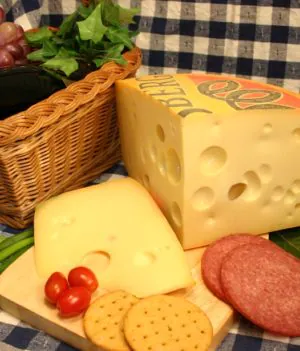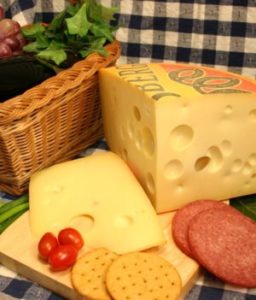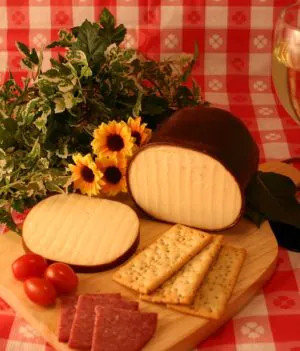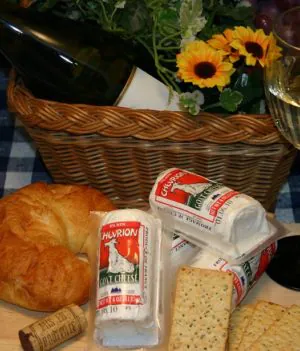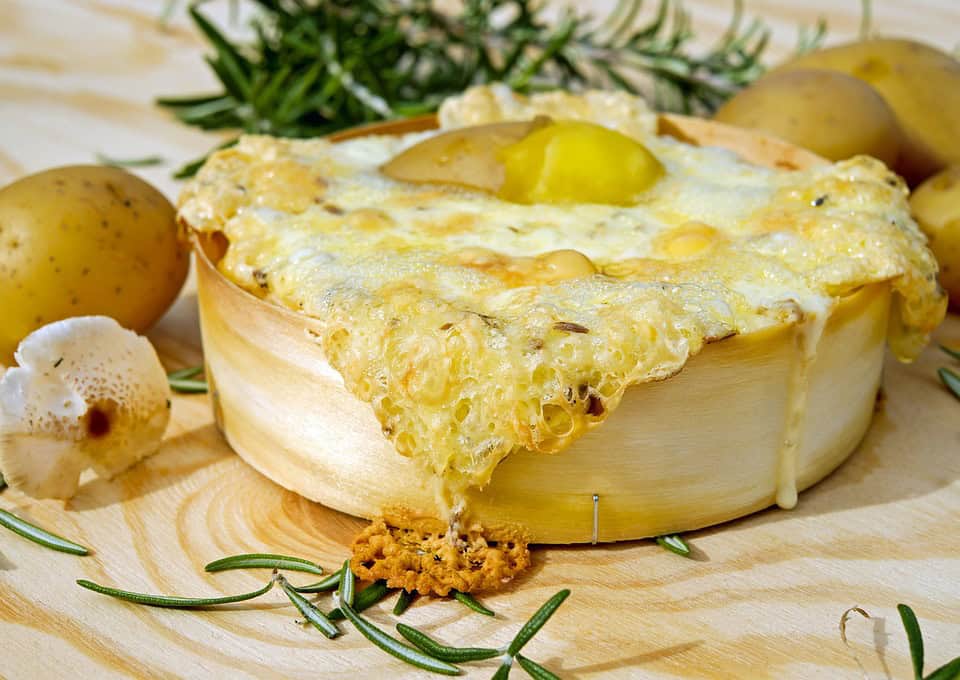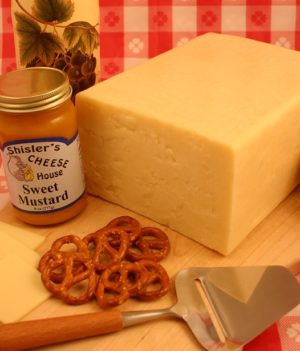Category: Cheeses
Jarlsberg Cheese: Everything You Need to Know
What is Jarlsberg Cheese?
Jarlsberg cheese is from Norway and is known for its distinctive sweet and nutty taste. It has large, round holes and a very buttery texture. It is almost sweet whilst having a clean flavor.
It has become popular around the world, with huge sales in both the United States and the United Kingdom.
History of Jarlsberg Cheese
Cheese with holes has been made in Laurvig and Jarlsberg, in the south of Norway, since the 1830s. In 1956, Professor Ole M. Ystgaard from the Agricultural University of Norway began doing research on these cheese recipes, recognizing the value of this type of cheese. During his research he developed a semi-hard, medium-fat cheese with large holes, successfully combining the cheese-making traditions with modern technologies. The new cheese was named Jarlsberg Cheese after the county where the earlier version had been made.
The holes are the result of cheese cultures added according to a secret recipe that is closely guarded. The cultures will create carbon dioxide, making bubbles in the cheese that eventually leave holes.
How to eat it
This versatile cheese is great on a cheeseboard but can also be eaten in a variety of hot and cold dishes.
It’s truly awesome melted onto a burger, perfect for barbecue season. It makes an excellent fondue, ready for dipping in bread, apple slices, and celery sticks. Add it to Mac and Cheese for extra nutty, cheesy flavor. Try it in paninis with ham or mushrooms (or both!). It’s also a great cheese for grating onto any baked savory dish to add a cheesy topping.
For true simplicity, slice it thinly and make a sandwich with your favorite bread. This is one of the best ways to enjoy the flavor of the cheese without distractions.
What to drink with Jarlsberg®Cheese
To complement Jarlsberg Cheese’s sweet, nutty flavor and open texture, choose light, fresh white wines rather than reds. Dry or semi-dry whites made from Chardonnay or Riesling grapes are your best bets. Think Chablis, White Burgundy, or a light, spicy Gewürztraminer.
Jarlsberg Cheese also works well with most beers. For those with a taste for stronger drink, it combines perfectly with Aquavit, a traditional Scandinavian liquor distilled with aromatic botanicals like caraway, cumin, cardamom, orange peel, aniseed, and fennel. This creates an experience you won’t soon forget.
Imported Cheeses
Jarlsberg Cheese is one of our newer imports and we are proud to stock it. We have been adding to our selection and will continue to add more in the future. Some of our other imported cheeses include Canadian Cheddar, Chevre, Danish Bleu Cheese, Gouda, Gruyere, Manchego, Mozzarella, Parmesan, Provolone, Raclette, and Pecorino Romano.
Have you tried Jarlsberg Cheese? Let us know in the comments.
Blue Cheese: Everything You Need to Know
What is blue cheese?
Blue Cheese is a generic term for cheeses that have had Penicillium cultures added creating dark blue or blue-grey veins throughout the cheese. It can be made from cow, sheep, or goat’s milk and is typically aged in a temperature and moisture-controlled environment like a cave.
How was blue cheese discovered?
Blue Cheese is said to have been discovered by accident. Cheeses in Europe were aged in high moisture caves which are also an ideal environment to produce mold. Gorgonzola dates back to around 879 AD and Roquefort was invented in 1070. Subsequent Blue cheeses were invented to fill the demand for Roquefort like cheeses. We prefer Danish blue, as it is more moderate in its sharpness and more creamy.
What does it taste like?
The characteristic flavor of blue cheese is usually sharp and salty, but levels of sharpness vary by region. It can be eaten by itself or crumbled or melted over foods. We know that blue cheese can divide opinion, so we’ve put together a list of tips that will help you to appreciate it!
Serve it at the right temperature
The unique flavor of blue cheese is best appreciated at room temperature to allow the flavors and textures to be enhanced. This goes for most cheeses: they should not be served straight from the fridge if you want to truly enjoy them.
Serve it with the right drinks pairing
Blue cheeses are strong, rustic-flavored cheeses and go best with similarly strong, flavored foods and drinks, and with tannic red wines such as Cabernet Sauvignon, Pinot Noir, Syrah, Zinfandel, and even Port. For beer lovers, the cheese compliments porters and stouts perfectly. It also pairs very well with Scotch, which is why we offer it with our Scotch collection.
Serve it with the right foods
Just as blue cheese deserves strong flavors from drinks, it needs them from food too. One classic combination is cheese with fruit. Pears, figs, and apples all stand up well to the flavor as they each have a sweetness that cuts through the saltiness of the cheese. The earthy quality of mushrooms brings out the same flavors in the cheese and the crunch of celery will contrast with the creaminess of any blue cheese.
It’s just as important to consider texture as well as flavor. Find crunchy foods to pair with the soft texture of the cheese and you’ll find it really stands out.
Start small
If you’re not yet a blue cheese fan, start by trying small pieces as part of a cheeseboard. You’ll gradually be able to move up to crumbling a little into soup or over pasta. In no time you’ll be asking for it on pizza and enjoying it with a glass of port! Let it surprise you. Sometimes we think we might not like something but in the right combination it is our new favorite dish.
Do you think you could become a blue cheese lover? We really do recommend trying our Danish Blue – it’s converted many a customer in the past!
Let us know your favorite blue cheese pairings in the comments!
Smoked Cheese: Everything you need to know
Are you a cheese lover? Have you ever tried smoked cheese?
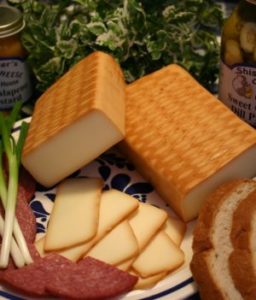
We stock a huge range here at Shisler’s Cheese House but we know that some customers don’t pick it up because they’re not sure about how it’s made or how to use it. That’s where this blog post comes in. We’re going to tell you everything you need to know about smoked cheese and show you some great uses for it so that you can add this delicious treat to your table.
A huge range of smoked cheese
We currently offer Smoked Baby Swiss, Smoked Bacon Cheese, Smoked Cheddar, Smoked Gouda, Smoked Habanero Cheddar, Smoked Horseradish Cheese, Smoked Hot Pepper Cheese, Smoked Mozzarella, Smoked Provolone, and Smoked Swiss Cheese.
That’s 10 smoked cheeses to choose from! We recommend that if you haven’t tried it before, start with a simple hard cheese such as the Smoked Cheddar or Smoked Gouda.
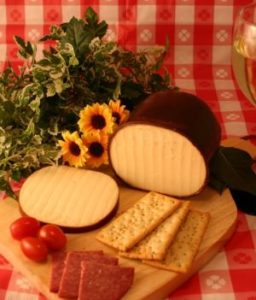
How is cheese smoked?
There are several ways to smoke cheese, but the main ones are the cold or hot smoke processes. The cold smoke method involves smoking chunks of cheese in a smoker for a few hours at a time with a tray of ice under the cheese. This allows the smoke to infuse into the cheese without it getting too hot and melting. Some smokers will keep the heat source separate to the cheese so that there is no need for the ice.
Smoked cheeses are usually aged for a brief period to allow the smokiness to mellow. The type of wood used will affect the flavor of the cheese. Common types of wood used include apple, oak, hickory, and chestnut. Our Smoked Cheddar is slowly smoked over a hickory fire to give it a deeply smoky flavor. So is our Smoked Horseradish Cheese which has a kick from the horseradish root and our Smoked Hot Pepper Cheese which is also really spicy. Our Smoked Mozzarella is smoked using both hickory and cherry wood smoke.

How should I eat smoked cheese?
There are so many ways to enjoy this but we are going to share just a few with you to give you inspiration today.
- On a cheeseboard
Add another dimension and extra flavor to your cheeseboard with smoked cheeses. They’re also great if you’re building a board around different textures of cheese. These are hard to semi-soft cheeses so you have a good range to choose from. Smoked cheese will surprise your guests if they haven’t tried it before!
- In a sandwich
Thin slices of smoked cheese alongside a good quality ham makes for a very special sandwich indeed. A sweet relish will offset the smokiness if you need some balance.
- On tacos
Grate some smoked cheese over your tacos for an authentic, smoky flavor.
- With fruit
Tart apples or white grapes are the perfect accompaniment to smoked cheese as the flavors marry really well.
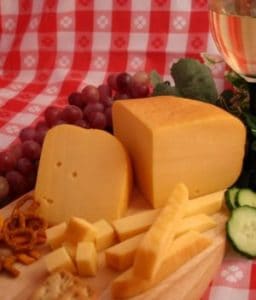
We hope you learned something about smoked cheese today! Have you tried it? Let us know in the comments!
Goat’s Cheese: 7 Ways to Eat It
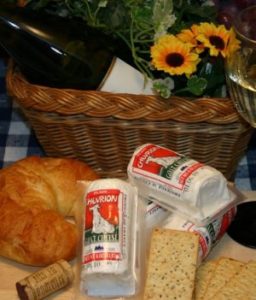
We absolutely love goat’s cheese here at Shisler’s Cheese House. We’re hoping that you will too and that’s why we’ve put together a list of 10 great ways to eat it.
We stock chevre goat’s cheese imported from France. This has a crumbly, cream cheese-like texture with a very creamy flavor. You’ll also get plenty of that goat’s cheese tang!
In a salad
This is how we often think of using goat’s cheese. It’s a classic for a reason! Crumble your cheese over salad leaves, roasted tomatoes and red peppers for a great combination. Add some pumpkin seeds for crunch and a balsamic vinegar dressing to bring everything together.
As a stuffing
Goat’s cheese works really well as a stuffing because it won’t melt too much and run out during cooking. Slice open a chicken breast and stuff it with the cheese, chopped tarragon, lemon zest and seasoning. Wrap the chicken in bacon or prosciutto and bake for approximately 20 minutes at 370F, until the juice runs clear.
On toast
It’s the simplest dish around but it’s still delicious! Spread some cheese on a piece of toast and dig in. You can even drizzle over some honey or spoon on some chopped fruit for a hint of sweetness.
With fruit
The creaminess and acidity of a crumbly chevre make it a very good friend to fruit. Try it with roasted fruits like figs, cherries, apricots, or peaches. It also goes really well with apples and honey. You can pair them in a tart, as a simple snack, or in a sandwich.
In pasta
Goat’s cheese works as a filling or a sauce for pasta dishes. Pair it with spinach, butternut squash or pine nuts. Stir it into a cream sauce with a little lemon zest to pack it full of flavor.
In a burger
There are a couple of ways to do this that will make your burgers pop. If you are making burgers from scratch, you can put a slice of goat’s cheese into the middle of the burger mix. Alternatively, add goat’s cheese on top of your burger whilst cooking or when you add it to your burger bun.
With a glass of wine
Goat’s cheese pairs really well with wine, but you’ll need to find one that stands up to strong flavors and the creaminess of the cheese. We recommend a Sauvignon Blanc, especially one from Sancerre if you can find it. The acidity of the wine will cut through all that creaminess and enhance the flavors of the cheese.
Do you like goat’s cheese? Which recipe would you try? Let us know in the comments!
Carolina Reaper Cheese: Our Hottest Cheese Yet!
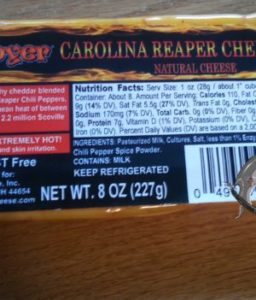
We know that you love spicy cheeses and that’s why we’re super excited to tell you about our Carolina Reaper Cheese. This is a rich and creamy cheddar blended with Carolina Reaper Chili Peppers. Tasting Carolina Reaper Cheese is an experience that you won’t forget! This cheese may actually cause a rush of endorphins, and may even put hair on your chest!
For reference, the Scoville Heat Scale measures how spicy foods are in Scoville units. A bell pepper has a Scoville rating of 0, with paprika reaching 1,000 and a jalapeno heading up towards 10,000. A Cayenne Pepper is between 30,000 – 50,000 Scoville units. Carolina Reaper pepper is between 1.4 million and 2.2 million Scoville units!
This is a cheese to try with friends. Watch their reactions as they try to withstand the spice. You could use this in recipes but be careful to only add a little at a time if you want to make something that is enjoyable to eat as well as surprisingly spicy! Our favorite way to enjoy it is to simply pair it with crackers and challenge our friends to eat it.
If you know the spice might be too much, have a glass of milk or a square of chocolate on hand. Casein, the protein found in milk, breaks down the bonds that capsaicin (the active component that makes chili peppers spicy) forms on our nerve receptors. Milk chocolate is best because of its higher volume of casein, but capsaicin is also more soluble in fat than in water, so it will be carried away by the fat content of the chocolate. We don’t need another excuse to eat some chocolate, but we think this fiery cheese might just need it!
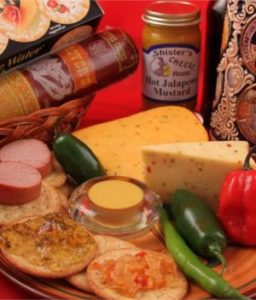
If you want to try a whole range of spicy cheeses then we have you covered:
Scorpion Cheddar is our second hottest cheese. It has 1.2 million Scoville units of heat. This is another one to take to a party and challenge your friends to take a bite.
Ghost Pepper Cheese is made from the Indian Bhut Jolokia pepper. It has a Scoville score of 855,000. This is a slow burner so be sure not to eat too much at once!
Hot Pepper Cheese is perfect for adding just a hint of spice, whilst still enjoying a creamy cheese.
We even offer a Hot Stuff Collection, which includes Hot Pepper Cheese, Habanero Cheese, Troyer’s Trail Bologna with Hot Pepper Cheese, Shisler’s Private Label Hot Pepper Relish, Shisler’s private label Hot Jalapeno Mustard, Hot Pepper Jelly, and Carr’s Crackers.
Do you love spicy cheeses? Let us know if you would try Carolina Reaper Cheese in the comments!
CAUTION: This cheese is extremely hot and can cause eye and skin irritation.
Asiago Cheese – Everything You Need to Know
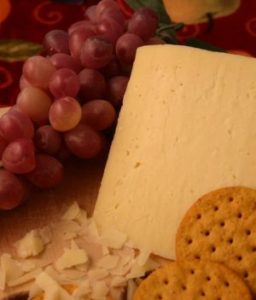
We are very proud of our cheese selection. We know that for some of you we might be stocking cheeses that you haven’t tried before, so we like to give you tips and tricks for how to use them. Today we are focusing on Asiago Cheese.
At Shisler’s we carry the aged version of Asiago (ah-SYAH-goh) Cheese, an Italian cheese more specifically known as Asiago d´Allevo. It is aged anywhere from three months to up to a year. The texture also varies from semi-firm to firm depending on how long it is aged and it contains small to medium holes throughout its body. It has a sweet and nutty flavor, reminiscent of Parmesan.
It is popular as a table cheese and is good when enjoyed with crackers, fruits, and red wine. Asiago is treated as interchangeable with parmesan and romano cheeses in some cuisines.
History of Asiago Cheese
Asiago cheese is an Italian cheese named after a region in Italy where it was first produced. This region is known as the Asiago High Plateau, which lies within the Italian Alps. As far back as the year 1000 AD, Asiago cheese was produced by farmers in this region for use locally. Now, it is manufactured commercially in northeast Italy, specifically in the provinces of Vincenza e Trento, Padua, and in Treviso.
How to Use Asiago Cheese
The aged cheese is often grated into salads, soups, pastas, and sauces while the fresh Asiago cheese is sliced to prepare panini or sandwiches. It can also be melted on a variety of dishes.
It is a brilliant cheese to bake into bread for a cheesy treat or grate over soft pretzels before baking. We also think it works particularly well with chicken dishes. Try pasta with asiago, chicken and a cream sauce or stuff a chicken breast with slices of Asiago and wrap it in pancetta or prosciutto before cooking. You could also try it instead of Parmesan when making a Caesar salad.
For a vegetarian dish, try roasted cauliflower with a cheese sauce made from asiago. Add toasted flaked almonds for a crunchy topping or even some raisins if you like sweet and savory dishes.
Wine Pairing with Asiago Cheese
Asiago Cheese, like many Italian cheeses, is fairly universal when it comes to wine pairing. It is more commonly paired with reds such as Beaujolais, Cabernet Sauvignon, Merlot, Pinot Noir, Syrah, and of course Chianti. For those who prefer white wines, Asiago cheese also pairs well with Chardonnay, Riesling, or Sauvignon Blanc. If you like to try cheeses with beer, we recommend an IPA or a Saison style beer, as the fruitiness will work well with the cheese.
Have you tried asiago cheese? What’s your favorite way to eat it? Let us know in the comments!
How to Create 3 Different Baked Cheeses

We’re always looking for new ways to serve cheeses. A cheeseboard is great, but sometimes you want a showstopping centerpiece to kick off a meal. Enter the baked cheese!
Read on to find out about how to bake three different cheeses and start your next dinner party (or just a fun night in) with a bang.
1. Camembert
Camembert is a surface-ripened cow’s milk cheese. It’s soft and creamy, with a pungent aroma. You’ll normally buy it in a wooden box. Start by unwrapping the cheese and making sure that any stickers have been removed. Replace it in its box. Make several cuts in the top of the cheese and add some garlic cloves and rosemary. Bake at 400F for 20 minutes, or until the cheese is gooey.
All you need to serve this are some slices of good bread, but you could also serve breadsticks and crudités. Gather everyone around and dip into the cheese. Don’t worry about the mess; it’s all part of the fun!
2. Raclette
Whilst you can serve raclette cheese at the table using a tabletop grill, you can also easily bake it in the oven. Simply put your cheese into a skillet with a drizzle of olive oil and any flavorings that you want to add such as herbs, garlic or spices. Bake it at 400F for around 8 minutes or until it is golden and bubbling.
You can serve this right up at the table with bread, boiled potatoes, sliced veg, salads or seafood. You could even serve pasta or steak at the same time. Raclette will work well with almost anything that you can think of. Serve it with a fruity white wine such as Sauvignon Blanc to make a real dinner party impression.
3. Feta
You might not have thought to bake feta before, but it’s delicious!
Feta is a sheep’s milk cheese from Greece. It is submerged in brine with gives it a salty, tangy taste. One of the simplest ways to bake it is to place the whole block of feta on a baking sheet, drizzle over 1tbsp of olive oil and the juice of a lemon, along with 1 crushed garlic clove and 1tsp oregano. Grind some black pepper on the top and put it in the oven at 400F for 5 minutes. It will start to brown at the edges, but no more as then it will dry out.
You can serve this in the middle of the table with some bread or alongside a salad. It’s even great broken up and stirred into pasta. You can experiment with the herbs and spices you add – chili, oregano, thyme, and sumac all work fantastically, but you can find your favorites. Another great variation is to surround the feta with tomatoes so that they roast at the same time. Serve this with a salad and you’ve got a perfect lunch.
So, you now have three baked cheeses to try out. Let us know which ones you loved in the comments!
5 Ways to Make Your Mac and Cheese Sensational
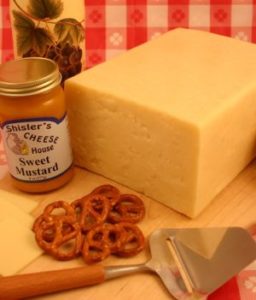
Today we’re sharing our favorite mac and cheese ideas. It’s one of the nation’s favorite foods, and for a good reason. Ooey, gooey cheese combined with delicious pasta make a comforting dish that can serve as an entree or a side.
As cheese lovers, we certainly know our way around mac and cheese. Read on to find out our top ideas for making it extra special.
1. Combine cheeses
You probably always use the same cheese when you make mac and cheese. Try something different to add new flavors and even more cheesiness. Some of our favorites to add are gruyere, for added nutty flavor, and mozzarella, for that extra melty goodness. You could also try bacon cheese or some of our spicy cheeses like hot habanero cheddar.
2. Add a topping
You might always sprinkle cheese on top, for those cripsy melted edges, but there are other ways to top your mac and cheese. Breadcrumbs, or even crushed up chips, can add another dimension to the dish. Crumbled up bacon will add saltiness and crunch. Toasted pumpkin seeds add a smoky element. Sliced chives or green onions will give your dish freshness. You can be creative with your toppings and find your family’s favorites.
3. Extra ingredients
You might have seen restaurants serving lobster or truffle mac and cheese. These are certainly decadent treats, but you don’t have to splash out to improve your mac and cheese at home. If you want to get more vegetables into your diet, try adding steamed asparagus, roasted squash or pumpkin, spinach or leafy greens. You can even stir pureed cauliflower or broccoli through your sauce to pack in some extra nutrients.
Seafood can work well, but it doesn’t have to be lobster. Crab meat and prawns are excellent stirred into a mac and cheese, but you could also add mussels on top.
Bacon, sausages, chorizo, bologna, and ham can add flavor and texture. You could even add chicken for more protein.
Spices are great for changing the flavor of your mac and cheese. Chilli and herbs are the classics, but horseradish can give it a great kick. You could even stir some pesto in for that Italian flavor!
4. Use sauces and condiments
Hot sauce, BBQ sauce, pickles and ketchup are all great toppings for your mac and cheese. Load up the table with different sauces and everyone can personalize their dish to their taste.
5. Really make the effort with the sauce
You might have never made a cheese sauce before, but it couldn’t be more simple. Trust us! All you’ll need is butter, flour, milk, cheese, salt, and pepper. Once you’ve made a sauce from scratch you won’t go back, and everyone will be clamoring for your recipe.
So, there you have it. Five ways to make your mac and cheese truly sensational. Which one will you try? How do you like to make mac and cheese? Let us know in the comments!
How to Shop For Cheese

You might be looking at the title thinking that you know how to go into a shop and grab some cheese… right?
But we are talking about how to shop for cheese and get the best experience possible. Today we’re going to share some tips to expand your cheese horizons.
1. Get to know your cheesemonger
When you pop into Shisler’s Cheese House, we’re always on hand to chat about cheese. We’ll help you find exactly what you need for that special occasion, pick the selection that will form the perfect cheeseboard, or show you the new cheeses that we have in stock.
If you’re shopping online you can still get in touch via our Facebook page or contact form.
2. Try cheeses made from different milk
You might always buy cow’s milk cheese and be missing out on sheep’s and goat’s milk cheeses. Try a variety of cheese and then you’ll always be able to buy your favorites. Trying different cheeses also means that you can eliminate the ones that you don’t like, which is just as important as finding the ones that you love.
3. Try different textures of cheese
You might always buy a hard cheese because you want it for sandwiches, but a soft or semi-soft cheese might be perfect for your party. Try all of the textures and you’ll find the ones for you.
4. Try cheeses from different countries
We have a huge range of imported cheeses ready for you to try. They’re sure to impress at a dinner party and you’ll be able to try out some new recipes.
5. Keep loving local cheeses
It’s great to try something imported, but there’s nothing like the taste of cheese that you know was made just a few miles down the road. You’ll be supporting local businesses and enjoying food with lower air miles.

6. Try different food pairings
Sometimes we decide that we don’t like a cheese, only to discover later that we like it with the right accompaniments. Don’t waste time finding this out later; try cheeses with different foods right away. Fruits, vegetables, pickles, and sauces can all change the flavor of cheeses. Ask us for recommendations to help you find the right combinations.
7. Try different drinks pairings
Just as trying cheeses with different foods can change your opinion of them, so can different drinks. Try a cheese with a recommended wine pairing to bring out its flavor. You might even find that a beer, whiskey or soft drink is the best pairing you. As always, experiment with flavors to get the most out of your cheese.
8. Don’t be afraid!
It can seem complicated or daunting to try new cheeses, especially if they’re really distinctive or new to you! But don’t be afraid, we are here to help. Even if you’ve always gone for the same cheese, you can become a cheese connoisseur in no time at all!
We hope that you’ve enjoyed our cheese shopping tips and now you’ll feel confident when you shop for cheese. Pop in and see us soon to try them out!
Why is Cheese Aged?

We all love eating cheese, but how much do we know about the process of making it? Today, let’s explore why cheese is aged and what this process does.
Aging cheese is sometimes called ripening. Some say that this is the most important part of the cheesemaking process because it gives each cheese its distinctive characteristics.
How does the cheesemaking process start?
Cheese is made by culturing milk, adding rennet and then separating the curds from the whey. These curds make cheese and are usually salted to start the process.
We eat some cheeses, such as ricotta and mozzarella, when they are young and unripened. However, most cheeses are aged for varying lengths of time.
Why are cheeses aged?
Cheeses are aged in order to transform the texture and intensify the flavor. The microbes and enzymes contained within the cheese react to the temperature and moisture of their environment, creating the different cheeses that we know and love.
What happens whilst a cheese is aging?
Over time, the cultures that were added to the cheese will grow and eat the lactose in the milk, changing it into lactic acid. Lactic acid gives cheeses their sharpness and tanginess.
There is also a process known as proteolysis, where the long protein strands created when the rennet was added begin to break down. These are responsible for the flavors that we experience in aged cheeses such as gouda and parmesan. If a cheese is smoky or nutty, it is because of the proteolysis.
This proteolysis also creates the gooey texture found in camembert, brie and limburger cheese.

Who is in charge of the aging process?
The person who looks after the cheese and decides how it is aged is known as an affineur.
Where are cheeses aged?
This all depends on the cheese and the desired effect of the aging.
Cheeses have historically been ripened in caves. Caves have a cool temperature and a high humidity, which allows the cheese to ripen without losing too much volume. Cheese is also very porous and so it takes on flavor from its surroundings. Aging in a cave allows the cheese to develop a strong, nutty flavor.
Some cheeses will be aged in a refrigerator or in a cool space such as a cellar. The affineur will make careful choices about the humidity and temperature involved to create the final product.
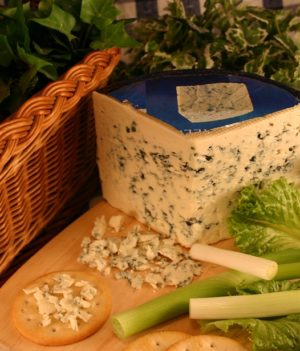
What about blue cheeses? How are they ripened?
Blue cheeses, such as Danish Blue and Stilton, have Penicillium cultures added to them. Tiny holes are made in the cheese to allow the air to reach the cultures. This encourages the blue/green veins that we recognize to form.
Can I age cheese that I have made at home?
Yes, you can. We recommend reading as much as you can about the cheese you are making before doing so. Some cheesemakers have had success using a wine refrigerator or spare refrigerator to age cheeses.
So, now you know about the cheese aging process! Do you have other questions about cheese making? Let us know in the comments and we’ll do our best to answer them!

